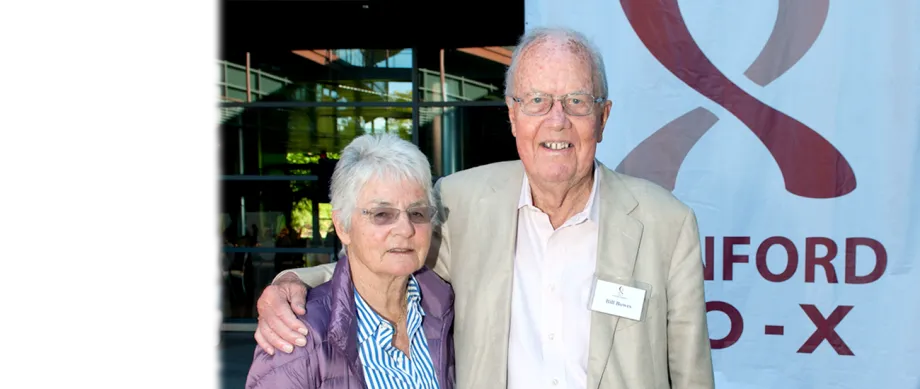
Photo by Steve Castillo: William and Ute Lumkemann Bowes.
March 7, 2017 - by Nathan Collins
William Bowes, Jr. ’50, left a mark on Stanford Bio-X, and not just as a key benefactor.
“His vision of the future launched the Stanford Bio-X Fellowship Program in 2004,” said Carla Shatz, the David Starr Jordan Director of Stanford Bio-X, Sapp Family Provostial Professor, and professor of biology and neurobiology. “Bill has now contributed to the training of over 200 young scientists—our future.”
When he passed away late last year, Bowes was best known as a founding partner at U.S. Venture Partners, which invested in over 300 early-stage companies over 30 years. He also was a founding shareholder at Amgen, as well as its first chairman and treasurer.
But Bio-X will remember him first and foremost as a pioneering philanthropist.
His support for basic research and early career scientists included funding 134 Bio-X Bowes Fellows and dozens more who’ve been part of the wider Stanford Bio-X Fellowship Program, which for the first time allowed Stanford Ph.D. and M.D./Ph.D. students to pursue research at the intersections of biology, medicine, engineering and physical science.
“He wanted to be involved with the students,” said Heideh Fattaey, the institute’s executive director.
“He would regularly drive down from San Francisco to meet with the students and their faculty mentors to hear about their work and provide some advice—his vision for the interdisciplinary fellowship program has become an inspiration for many other programs across Stanford’s campus and around the world. Bill was a pioneer in helping Bio-X educate the scientists of the future.”
Kate Montgomery, MS ’11, PhD ’15, was one of those young scientists. As a Bio-X Bowes Fellow from 2009 to 2012, Montgomery pushed the boundaries of pain management using optogenetics, a gene-therapy technique that allows scientists to activate signaling in cells in the body using light. Building on that idea, and working with Scott Delp, the James H. Clark Professor in the School of Engineering, Karl Deisseroth, the D. H. Chen Professor in the School of Medicine, and Ada Poon, an associate professor of electrical engineering, Montgomery helped develop tiny wirelessly powered lights that she used to target pain-sensing nerve cells in mice to block pain signals.
Montgomery graduated in 2015 and is now the lead research and development scientist at Zebra Medical Technologies, whose technology grew out of Bio-X-funded research.
The most recent crop of Bio-X Bowes Fellows includes Avanti Shrikumar, PhD ’20, a computer scientist focused on embryonic stem cells. As an embryo develops, those cells eventually become eyes, spleens, and every other sort of specialized tissue in our bodies. In theory, these embryonic cells could be used to treat any number of diseases or even to produce organs for the nearly 120,000 people in the U.S. alone who need a transplant—if researchers knew more about how they work.
Shrikumar’s hope is to develop new methods based on deep learning, a set of techniques related to artificial intelligence, to make sense of the growing body of data on stem cells. She’s carrying out this work with Anshul Kundaje, an assistant professor of genetics and computer science, and Helen Blau, the Donald E. and Delia B. Baxter Foundation Professor in the School of Medicine.
Those are just two examples of Bowes’s legacy. Other current fellows are using computer science and biophysics to tackle cancer, developing wearable robotics for people with spinal injuries and lost limbs, and chasing solutions to the emerging public-health threat of antibiotic resistance.
Bill received a BA in economics from Stanford University in 1950 and an MBA from Harvard University.
Bill was a founding member of the Interdisciplinary Biosciences Advisory Council which later became the Bio-X Advisory Council. He also was president of the William K. Bowes, Jr. Foundation.
In addition to Bill’s significant support of Stanford Bio-X, he also established the Ruth G. and William K. Bowes Professorship in the School of Engineering and helped launch the Stanford Engineering Venture Fund (SEVF), an investment partnership between Stanford, leading venture capitalists, and local tech companies. SEVF provided funds for fellowships, an entrepreneurship program, and buildings.
“Bill was a loyal, generous, and thoughtful donor to Stanford,” Shatz said. “His contributions to Bio-X were key to its success.”
What Bowes helped start in 2004 will continue: Bio-X will announce the 2017 class of Bio-X Bowes Fellows on May 17.
